A letter from Artemisia Gentileschi to the Author
“Eternally Artemisia. Some loves, like some women are timeless.” A novel by Melissa Muldoon.
A letter from Artemisia Gentileschi to the author.
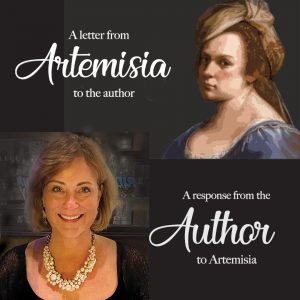
Cara Melissa,
I wanted to thank you for the novel you have published about me. As you were writing it, I’m sure you felt my presence by your side. I was always there looking over your shoulder, whispering things into your ear, helping you to imagine my life and the things I experienced.
When I read your final manuscript, I was pleased. To create an emotive picture, I paint with colors, but you paint with words, and like a work of Baroque art, your story evokes strong emotions. It captures the fear and pain I felt during Tassi’s rape trial and the happiness that welled inside me when I was painting in my studio in Florence that looked out over the Arno River, with little Prudentia asleep in the next room.
Through your pages, once again, I walked through Cosimo’s city and felt the reverberations of horse hooves and rumbling carriage wheels. Hearing the girls down by the river chatter with boatmen or the silk dyers singing I felt the creativity that pulsated through the town and the sensation of freedom. What a revelation that a woman could walk easily over the bridge to the Oltrarno to purchase her own brushes, oils, and pigments. It was so unlike Rome, where I grew up, where a girl was accosted on every corner. There, sometimes, the Tiber ran red with blood from the executioner’s block, no matter if the victims were innocent.
As you know, even as a young girl working as an apprentice in my father’s studio, long before being tutored by Agostino and suffering through that humiliating trial, painting was everything to me. I couldn’t imagine my existence without a brush in one hand and a palette in the other. There is something exhilarating about creating a powerful, vivid piece of art that will endure through time. Painting has been my life and my salvation, keeping me sane when I thought I might go mad from despair and loneliness. It has been the one constant in my turbulent life — the one thing I know will endure.
Yes, some art is eternal, but some loves are also timeless. Despite all I’ve been through, I still believe that profound attachments exist between two souls who experience life so intensely and passionately they are cosmically bound together. They endure through all seasons, never fading away, and are fated to meet repeatedly. I tried to explain this to Maddalena when we were reunited after so many years apart. At first, she couldn’t comprehend what I was trying to tell her. That is until she came to Italy and met the Crociani family, who have ties to Cosimo de Medici’s court in Florence. You know what a good friend and patron Cosimo was to me. He, along with Galileo and Matteo Crociani, of course! When Maddie first saw Matteo and their eyes met — it was then she remembered, and she believed, and we began our journey together.
You and I, dear friend, have also shared a journey that has taken us far. I have enjoyed our time together immensely. Now, as you can well imagine, there is a painting sitting on my easel that I must attend to. It sits there half done, calling to me, and my fingers are ready to pick up a brush once again. Just know that I am touched and gladdened you chose my story to share with readers. I hope they, too, will be inspired and find the thing they are most passionate about. For when we women unite, there is nothing we cannot achieve. We can even touch the stars!
Until we meet again, I am eternally yours, Artemisia
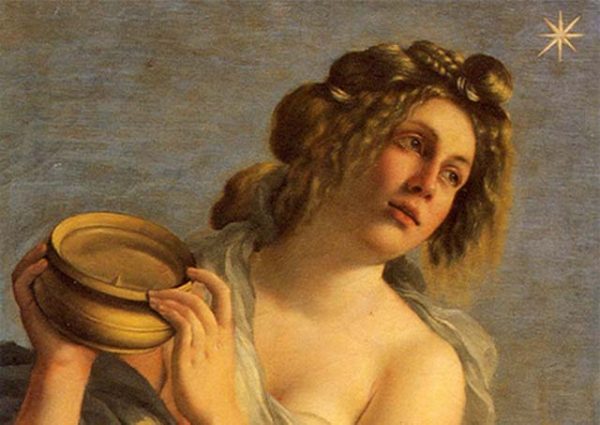
Image Credit: Detail from ‘Allegory of Inclination’ (1617) Self-portrait by Artemisia Gentileschi.
The author’s response to Artemisia and readers.
I thank you from my heart, Artemisia for being a role model for all women and the inspiration for my novel. After researching your story and falling in love with your art, I feel our paths have crossed before and will continue to do so in the future.
“Eternally Artemisia,” the novel I wrote about Artemisia, the seventeenth-century artist, is based on fact and well-documented historical details blended with a bit of fantasy and imagination.
They say there are many Caravaggisti, but only one Caravaggista!
Not only did Artemisia find the courage to paint in a field dominated by men, but she also eclipsed most of them, including her father, her husband, and all the men who tried to imitate Caravaggio’s style.
Ever since I first met Artemisia in a darkened Art History classroom, looking at slides of her paintings and learning her story, I found it as relevant today as it was then and one that shouldn’t be forgotten. Artemisia left her mark on the world through hard work, humility, resilience, and integrity. Despite being sexually abused, beaten down, and betrayed by those she loved and believed; she never gave up.
In a time when it was unheard of to denounce a man for the crime of rape, Artemisia did just that. At sixteen, she took her assailant, Agostino Tassi, her painting instructor, and the man who had promised to marry her, to court. But in the end, Artemisia was put on trial to prove her accusations weren’t false. In front of a jury of men, she was forced to endure a physical examination to establish she was no longer a virgin. She was also tortured by the Sibille. As Tassi watched from a comfortable chair, the judge ordered cords to be wrapped around Artemisia’s fingers. Each time the magistrate asked Artemisia if she were innocent, the leather straps were pulled tighter, crushing her artistically gifted hands. To every question, despite the pain, Artemisia cried out, “‘È vero, è vero, è vero, è vero… it is true, it is true, it is true!”
Tassi was ultimately convicted, but he didn’t spend a day in jail. On the other hand, despite being the victor, Artemisia was left a disgraced and fallen woman. With her reputation in shreds, considered a wanton woman, her only option was to relinquish painting forever and retreat to a convent. However, in a conniving move, her father, Orazio, paid off a philandering Florentine painter to take his daughter off his hands.

Image Credit: Artemisia Gentileschi, Judith e Holofernes
It was a dark, depressing time for Artemisia, but she never abandoned her passion for painting. Quite the opposite. She threw herself fervently into her work, which helped to heal internal emotional wounds. Painting images of herself and her aggressor in violent scenes taken from the Bible like “Judith and Holofernes,” the artist worked through the traumatic emotional damage that violence against women causes. Over time, Artemisia and her art triumphed; she became Cosimo de Medici’s protégée, Galileo’s friend, and the first female to be admitted to the prestigious Florentine Art Academy. She determinedly and shrewdly succeeded in a male-dominated society in Florence to become a celebrated painter to European kings and princes.
To tell Artemisia’s story, I wanted the artist to speak to readers directly, using her own words, in her own time. But I also wished to convey all aspects of Artemisia’s life and the aftershocks that rippled on for many centuries. To do so, I created a story that weaves together plot lines from the past, present, and future.
While many things have changed in the last five-hundred years since Artemisia’s trial, women through the centuries continue to face many of the same barriers and sexual abuse as did my seventeenth-century heroine. To address current problems of violence against women and the restorative effects of art therapy, I created the character of Maddie, a modern-day psychiatrist. Conducting a summer retreat in Tuscany, she applies Artemisia’s art therapy techniques to guide women, victims of sexual violence, to a path of healing, helping them take back their power.
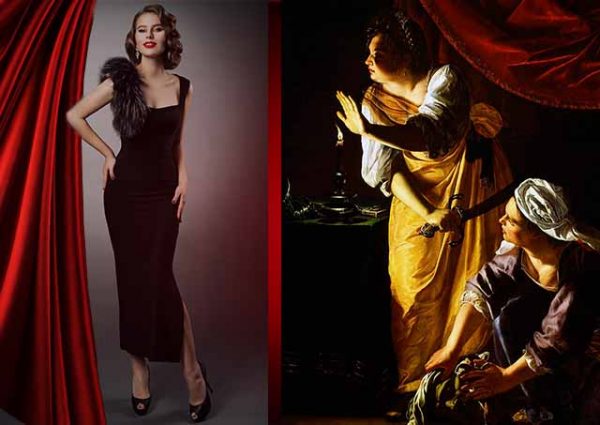
Model dressed in ’30 vintage eveningwear / Artemisia Gentileschi, Judith e Holofernes
Through another persona of Maddie, the notorious fashion designer called Maddalena, the story reanimates in the 1930s, an important period in Artemisia’s story when her paintings were rediscovered. Due to changing tastes in art, Gentileschi’s paintings fell into relative obscurity, for centuries forgotten or attributed to male artists. Artemisia’s work was brought to light and properly credited by Art Historians during a surge of rediscovery in the early years before World War II.
In the novel “Eternally Artemisia,” as Maddie’s relationship with Artemisia Gentileschi develops, she discovers a kindred spirit and mentor. On a journey that arcs back to biblical days and moves forward in time, Maddie encounters artists, dukes, designers, movie stars, and baser and ignoble men. With Artemisia never far from her side, she proves that when we dare to take control of our lives and find the “thing” we are most passionate about, we are limitless and can walk upon the Galilean moons.
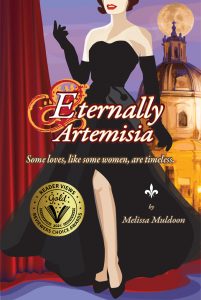
BUY THE BOOK HERE
Link to Eternally Artemisia book video trailer:
https://www.youtube.com/watch?v=NKurWrS4TVM&t=10s

Author Bio
Melissa Muldoon is the author of four novels set in Italy: Dreaming Sophia, Waking Isabella, Eternally Artemisia, and The Secret Life of Sofonisba Anguissola. All four books tell the stories of women and their journeys of self-discovery to find love, uncover hidden truths, and follow their destinies to shape a better future for themselves. Melissa is also the author of the StudentessaMatta.com website, where she promotes the study of the Italian language and culture through her dual-language blog written in Italian and English (studentessamatta.com).
Melissa has a B.A. in fine arts, art history and European history from Knox College, a liberal arts college in Galesburg, Illinois, and a master’s degree in art history from the University of Illinois at Champaign-Urbana. She has also studied painting and art history in Florence. She is an artist, designer, and illustrated the cover art for her books. Melissa is also the managing director of Matta Press. With the help of a team of Italian teaching professionals, she translated her second novel Waking Isabella, into Italian, Il risveglio di Isabella into Italian, and it is available in print. She also curates the Art of Loving Italy website and Pinterest site, where you will find companion pictures and visual references for all four of her books. Visit MelissaMuldoon.com for more information about Melissa’s books and StudentessaMatta.com for tips to learn and practice Italian at home and in Italy with Melissa.
5 Stars – Dianne Hales (author of La Bella Lingua, La Passione, and Mona Lisa-A Life Discovered): A true Renaissance woman, Melissa Muldoon weaves her passions for art and Italy into a stirring saga that sweeps across centuries. As her time-traveling heroine, Maddie reconnects with kindred souls, we meet Artemisia Gentileschi, the 17th–century artist who overcame rape and ignominy to gain respect and acclaim. Historical figures such as Galileo and Mussolini also come to life in this intricately plotted novel. Still, the women who defy all constraints to take control of their destinies are the ones who prove to be eternally fascinating.
5 Stars – Lize Amazon Reader: What a lovely story! Melissa weaves the lives of 4 women across time, all with some connection to Artemisia Gentileschi, a 16th-century Italy painter. They represent the feminine strength that arises from life challenges, each with unique intelligence. Underlying their stories is the idea that love transcends all, even time; love is timeless. As with her other books, Melissa fills the story out with interesting facts and references to Italian life, culture, and its history; her attention to detail is immaculate. I loved the many connections in this story that tied it all together; very cleverly done. Wonderful read; I would highly recommend it.
Category: On Writing






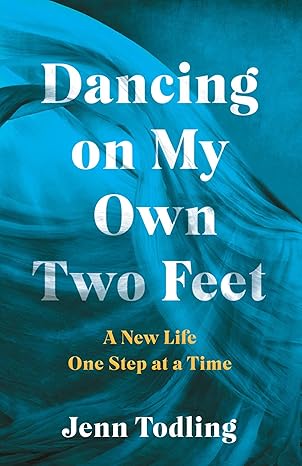






















Fascinating! This must be (I will find out for sure, ordering it now!) a great book. I am looking forward to learning more about Artemisia Gentileschi, as well as taking a look at the author’s book about Sofonisma Anguissola.
Caravaggio’s Judith and Holofernes, as a work of art rather then about the artist, features in one of my own books, but I’m excited to read about the great women who went unrecognized, or maligned for their recognition. Congratulations on this newest book!